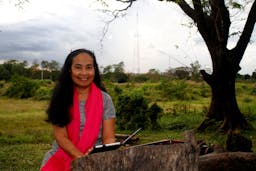Lumad IDPs hope for joint ceasefire in government-rebel talks
May 28, 2019
Story
Two years ago, when breastfeeding mothers among them could not produce milk for their infants and the sick could not have medications, at least a dozen of the lumad (Indigenous peoples) women evacuees cut their waist-long hair and sold the strands to a wigmaker so they could buy milk and medicines, recalled Sareza Ocampo, spokesperson of Tagtabulon, the Higaonon grassroots organization.
But today, as the same group of 156 internally displaced persons (IDPs) marked the fifth day of their fifth evacuation in three years at a public park fronting the provincial capitol here, Ocampo noted that none of the women’s hair has grown long enough to be sold and yet, they still face the same lack of resources that has worsened their predicament.
Ocampo further said that aside from the ration of rice and canned goods, which are about to run out, the evacuees need mosquito nets, blankets and sleeping mats. They are presently sheltered by tarpaulin tents and lean-tos provided by humanitarian non-government organizations, and have slept on cardboard boxes and old posters spread on the park’s concrete grounds.
‘’We were told by the government's social welfare officer that we might not be given sleeping mats, blankets and mosquito nets because they already handed out these to us two years ago, but we could not bring most of these as we left our village in a hurry and most have already disintegrated,’’ Ocampo explained.
‘’We also need firewood so that we can cook our meals,’’ she said, adding that while they were given rice rations, they were not provided firewood. They also need pails and washtubs, laundry soaps and hygiene kits.
The Tagtabulon’s assertion for government support, according to Ocampo, is based on the International Humanitarian Law and the Geneva Conventions, that seek to protect civilians, non-combatants or people who are not part of the hostilities or armed conflict, especially vulnerable groups like women, children, the elderly and the disabled. The Philippines is a signatory to the treaties and the additional protocols.
The displacement of the Higaonon comes on the heels of the resumption of the peace talks between the government and the National Democratic Front (NDF) that began on April 3 in The Netherlands. The military’s 58th Infantry Battalion of the Fourth Infantry Division has been conducting ‘’combat and clearing operations’’ in the eastern towns of Lagonglong, Binuangan, Balingasag, Salay and Subongcogon since February this year as peace talks to end the 48-year communist-inspired insurgency, began in August last year, ground to a halt on the behest of President Rodrigo Duterte.
But even as the Netherlands talks began, neither the government nor the New People’s Army has issued unilateral ceasefires. The NPA ended its unilateral ceasefire in January after the third round of talks in Rome but prior to President Duterte’s declaration to end the talks.
According to Ocampo, the Higaonon IDPs would surely welcome a joint ceasefire agreement, which both peace panels are expected to pursue. ‘’The root cause of our constant displacement has been the entry of the military into our village. With a ceasefire, we are assured that both the rebels and the government soldiers will keep off our village,’’ she added.
Ocampo said that as in the past they endured stares and taunts from passersby and even from duty-bearers; they endured late meals and half-cooked rice; they endured the dust and buzzing flies during the day and the buzzing and biting of mosquitoes at night rather than run the risk of being caught in the crossfire in a soldiers-rebels clash.
The phenomenon of conflict-induced displacement among the lumad population in Mindanao peaked in 2015 year as lumad communities, numbering about 40,000, in four provinces left their homes in the wake of militarization of remote communities.
The Higaonon evacuees from sitio Camansi had pointed out that militarization had forced them out from their villages. They evacuated in October 2014, in May and June 2015 and in June last year.
“About a hundred army soldiers arrived early morning last March 29, and went house to house to distribute leaflets against the rebels, and demanded that would need to stay to conduct security operations,’’ Ocampo said.
“It felt like my entire body ached all over, and my head throbbed with pain, and I was anxious all the time. My toddler kept crying but no milk came from my breast,” said Sareza.
Because of their potent roles in peace building and conflict resolution, lumad women’s health and well-being must be given priority focus in the healing process consequent to post-conflict peace building. It is hoped that such data will contribute to the body of knowledge needed to implement, on the national and local levels, such global instruments as the UN Declaration on the Rights of Indigenous Peoples, UN Security Council Resolution 1325, the Universal Declaration of Human Rights, the International Humanitarian Law, and the Beijing Platform for Action that all emphasize the need to address and respond to the impact of armed conflict on women and girls, thus ensuring their individual and collective survival, recovery and empowerment in their communities.
How to Get Involved
To support Libudsuroy's independent coverage of indigenous women in Mindanao and the work of other World Pulsers like her, give to World Pulse's Changefunder Program.
To provide direct support to lumad women in Mindanao resisting the impact of militarization, contact the Rural Missionaries of the Philippines-Northern Mindanao Region) email: info@rmp-nmr.org




